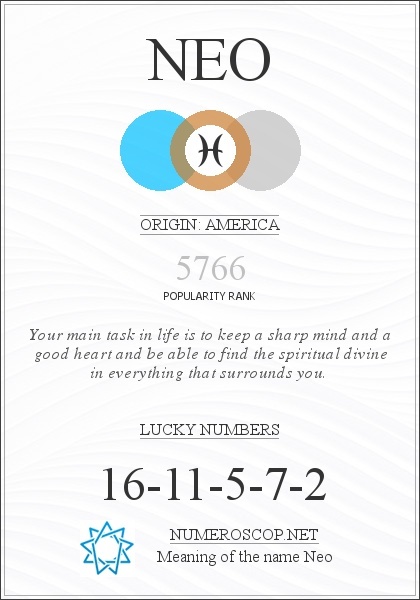
#Neo definition how to
A nurse or other health care provider will teach you how to self-catheterize. In self-catheterization, you put a narrow tube (catheter) through the opening to your bladder (urethra) to drain urine and relieve pressure on the bladder. If this happens, you need to be willing to do self-catheterization. Learning to self-catheterizeīeing unable to empty the bladder completely (urinary retention) is a potential complication of neobladder reconstruction.

In some cases, you may need to stop these medications before your surgery. Let your doctor know about all of the medications, vitamins and dietary supplements you're taking. You'll likely need to stop eating and drinking after midnight on the night before your procedure. Your surgeon may ask you to have a clear liquid diet for 1 to 2 days before surgery. Several complications may occur with neobladder reconstruction, including: troops accused of damaging Babylon's ancient wonder CNN.Request an Appointment at Mayo Clinic Risks Sourcesįinal Report on Damage Assessment in Babylon UNESCO.Īncient tablets reveal life of Jews in Nebuchadnezzar’s Babylon Reuters. The site was reopened to tourists in 2009. The United Nations cultural heritage agency UNESCO reported the base caused “major damage” to the archaeological site. Under Saddam Hussein, the Iraqi government excavated Babylonian ruins and attempted to reconstruct certain features of the ancient city, including one of Nebuchadnezzar’s palaces.Īfter the 2003 invasion of Iraq, United States forces built a military base on the ruins of Babylon. German archaeologists excavated the remains of the gate in the early twentieth century and reconstructed it in Berlin’s Pergamon Museum using original bricks. In ancient Babylon, the new year started with the spring equinox and marked the beginning of the agricultural season. The Ishtar Gate gave way to the city’s great Processional Way, a half-mile decorated corridor used in religious ritual to celebrate the New Year. Some researchers have uncovered evidence that suggests the hanging gardens existed, but not in Babylon-they may have actually been located in the city of Nineveh in upper Mesopotamia. It’s unclear where they were located or whether they ever existed at all. Yet archaeologists have turned up scant evidence of the gardens. The Hanging Gardens of Babylon, a colossal maze of terraced trees, shrubs, flowers and manmade waterfalls, are one of the Seven Wonders of the Ancient World. The shrine stood 280 feet tall, nearly the size of a 26-story office building. He also built a number of shrines, the largest of which, called Esagil, was dedicated to Marduk.

Nebuchadnezzar II built three major palaces, each lavishly decorated with blue and yellow glazed tiles.

The city inside the walls occupied an area of 200 square miles, roughly the size of Chicago today. The Greek historian Herodotus wrote that the walls of Babylon were so thick that chariot races were held on top of them. Babylon In Jewish HistoryĪfter the Babylonian conquest of the Kingdom of Judah in the sixth century B.C., Nebuchadnezzar II took thousands of Jews from the city of Jerusalem and held them captive in Babylon for more than half a century. The fall of Babylon was complete when the empire came under Persian control. In 539 B.C., less than a century after its founding, the legendary Persian king Cyrus the Great conquered Babylon. The Neo-Babylonian Empire, like the earlier Babylonia, was short-lived. The Babylonians built many beautiful and lavish buildings and preserved statues and artworks from the earlier Babylonian Empire during the reign of King Nebuchadnezzar II. The Neo-Babylonian Empire enjoyed a period of cultural renaissance in the Near East. The Neo-Babylonian Empire became the most powerful state in the world after defeating the Assyrians at Nineveh in 612 B.C.

READ MORE: How Hammurabi Transformed Babylon Into a Powerful City-State Neo-Babylonian EmpireĪ new line of kings established the Neo-Babylonian Empire, which lasted from 626 B.C. The empire fell apart after Hammurabi’s death and reverted back to a small kingdom for several centuries.


 0 kommentar(er)
0 kommentar(er)
